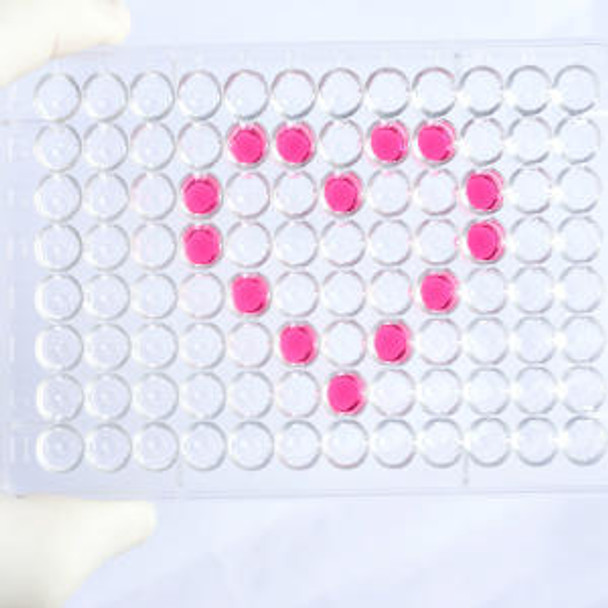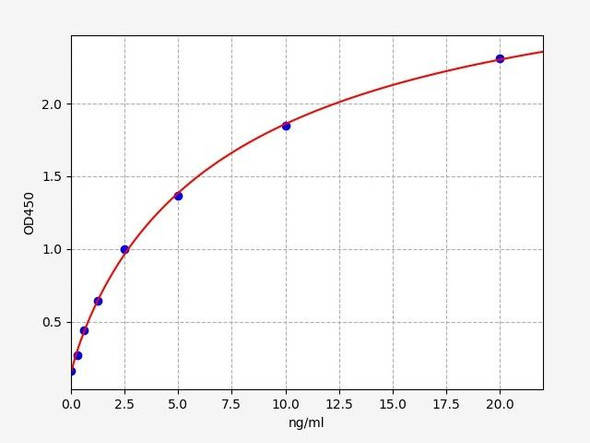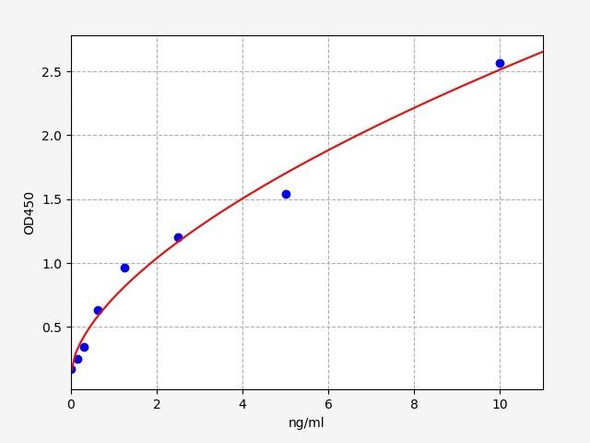Human Estrogen receptor beta (ESR2) ELISA Kit (HUEB2337)
- SKU:
- HUEB2337
- Product Type:
- ELISA Kit
- Size:
- 96 Assays
- Uniprot:
- Q92731
- Range:
- 0.312-20 ng/mL
- ELISA Type:
- Sandwich
- Synonyms:
- ErBeta, ESR2, NR3A2, Erb, ER-beta, ER-BETA, ESR-BETA, ESTRB, estrogen receptor 2, ER beta, estrogen receptor beta 4, NR3A2ESRB, Nuclear receptor subfamily 3 group A member 2
- Reactivity:
- Human
Description
Human Estrogen receptor beta (ESR2) ELISA Kit
The Human Estrogen Receptor Beta (ESR2) ELISA Kit is a powerful tool for the quantitative measurement of estrogen receptor beta levels in human samples, including serum, plasma, and cell culture supernatants. This kit offers exceptional sensitivity and specificity, ensuring accurate and precise results for a variety of research applications.Estrogen receptor beta is a vital protein involved in mediating the effects of estrogen in the body, playing a key role in various physiological processes.
Dysregulation of estrogen receptor beta has been linked to hormone-related conditions such as breast cancer, osteoporosis, and cardiovascular diseases, making it a valuable biomarker for understanding these diseases and developing potential therapies.With its reliable performance and ease of use, the Human Estrogen Receptor Beta (ESR2) ELISA Kit is an indispensable tool for researchers studying estrogen receptor biology and its implications in health and disease.
| Product Name: | Human Estrogen receptor beta (ESR2) ELISA Kit |
| SKU: | HUEB2337 |
| Size: | 96T |
| Target: | Human Estrogen receptor beta (ESR2) |
| Synonyms: | Nuclear receptor subfamily 3 group A member 2, ER-beta, ESTRB, NR3A2 |
| Assay Type: | Sandwich |
| Detection Method: | ELISA |
| Reactivity: | Human |
| Detection Range: | 0.312-20ng/mL |
| Sensitivity: | 0.132ng/mL |
| Intra CV: | 4.7% | ||||||||||||||||||||
| Inter CV: | 7.9% | ||||||||||||||||||||
| Linearity: |
| ||||||||||||||||||||
| Recovery: |
| ||||||||||||||||||||
| Function: | Nuclear hormone receptor. Binds estrogens with an affinity similar to that of ESR1, and activates expression of reporter genes containing estrogen response elements (ERE) in an estrogen-dependent manner (PubMed:20074560). Isoform beta-cx lacks ligand binding ability and has no or only very low ere binding activity resulting in the loss of ligand-dependent transactivation ability. DNA-binding by ESR1 and ESR2 is rapidly lost at 37 degrees Celsius in the absence of ligand while in the presence of 17 beta-estradiol and 4-hydroxy-tamoxifen loss in DNA-binding at elevated temperature is more gradual. |
| Uniprot: | Q92731 |
| Sample Type: | Serum, plasma, tissue homogenates, cell culture supernates and other biological fluids |
| Specificity: | Natural and recombinant human Estrogen receptor beta |
| Sub Unit: | Binds DNA as a homodimer. Can form a heterodimer with ESR1. Interacts with NCOA1, NCOA3, NCOA5 and NCOA6 coactivators, leading to a strong increase of transcription of target genes. Interacts with PELP1 and UBE1C. Isoform 2 preferentially forms a heterodimer with ESR1 rather than ESR2 and inhibits DNA-binding by ESR1. Interacts with AKAP13. Interacts with DNTTIP2. Interacts with isoform 4 of TXNRD1. Interacts with CCDC62 in the presence of estradiol/E2; this interaction seems to enhance the transcription of target genes, including cyclin-D1/CCND1 AP-1 promoter. Interacts with DYX1C1 (By similarity). Interacts with PRMT2. Interacts with CCAR2 (via N-terminus) in a ligand-independent manner. |
| Research Area: | Cancer |
| Subcellular Location: | Nucleus |
| Storage: | Please see kit components below for exact storage details |
| Note: | For research use only |
| UniProt Protein Function: | ER-beta: a nuclear hormone receptor and transcription factor. Binds and activated by estrogen. Regulates gene expression and affects cellular proliferation and differentiation in target tissues. Binds estrogens with an affinity similar to that of ER-alpha, and activates expression of reporter genes containing estrogen response elements (ERE) in an estrogen-dependent manner. Eight alternatively-spliced isoforms have been described. Isoform beta-cx lacks ligand binding ability and has no or only very low ERE binding activity resulting in the loss of ligand-dependent transactivation ability. |
| UniProt Protein Details: | Protein type:DNA-binding; Nuclear receptor Chromosomal Location of Human Ortholog: 14q23.2 Cellular Component: nucleoplasm; mitochondrion; extracellular region; nucleus Molecular Function:receptor antagonist activity; protein binding; ligand-dependent nuclear receptor activity; estrogen receptor activity; enzyme binding; DNA binding; zinc ion binding; transcription coactivator activity; estrogen response element binding; steroid hormone receptor activity; transcription factor activity; steroid binding Biological Process: transcription initiation from RNA polymerase II promoter; estrogen receptor signaling pathway; induction of apoptosis by hormones; neuron migration; vagina development; negative regulation of transcription from RNA polymerase II promoter; uterus development; signal transduction; cell-cell signaling; ovarian follicle development; regulation of transcription, DNA-dependent; steroid hormone mediated signaling; gene expression; positive regulation of transcription factor activity; negative regulation of cell growth; brain development; negative regulation of epithelial cell proliferation |
| NCBI Summary: | This gene encodes a member of the family of estrogen receptors and superfamily of nuclear receptor transcription factors. The gene product contains an N-terminal DNA binding domain and C-terminal ligand binding domain and is localized to the nucleus, cytoplasm, and mitochondria. Upon binding to 17beta-estradiol or related ligands, the encoded protein forms homo- or hetero-dimers that interact with specific DNA sequences to activate transcription. Some isoforms dominantly inhibit the activity of other estrogen receptor family members. Several alternatively spliced transcript variants of this gene have been described, but the full-length nature of some of these variants has not been fully characterized. [provided by RefSeq, Jul 2008] |
| UniProt Code: | Q92731 |
| NCBI GenInfo Identifier: | 6166154 |
| NCBI Gene ID: | 2100 |
| NCBI Accession: | Q92731.2 |
| UniProt Related Accession: | Q92731 |
| Molecular Weight: | Predicted: 53 kDa |
| NCBI Full Name: | Estrogen receptor beta |
| NCBI Synonym Full Names: | estrogen receptor 2 (ER beta) |
| NCBI Official Symbol: | ESR2 |
| NCBI Official Synonym Symbols: | Erb; ESRB; ESTRB; NR3A2; ER-BETA; ESR-BETA |
| NCBI Protein Information: | estrogen receptor beta; estrogen receptor beta 4; nuclear receptor subfamily 3 group A member 2 |
| UniProt Protein Name: | 5p152 |
| UniProt Synonym Protein Names: | 5p152 |
| Protein Family: | Estrogen receptor |
| UniProt Gene Name: | ESR2 |
| UniProt Entry Name: | Q7LCB3_HUMAN |
| Component | Quantity (96 Assays) | Storage |
| ELISA Microplate (Dismountable) | 8×12 strips | -20°C |
| Lyophilized Standard | 2 | -20°C |
| Sample Diluent | 20ml | -20°C |
| Assay Diluent A | 10mL | -20°C |
| Assay Diluent B | 10mL | -20°C |
| Detection Reagent A | 120µL | -20°C |
| Detection Reagent B | 120µL | -20°C |
| Wash Buffer | 30mL | 4°C |
| Substrate | 10mL | 4°C |
| Stop Solution | 10mL | 4°C |
| Plate Sealer | 5 | - |
Other materials and equipment required:
- Microplate reader with 450 nm wavelength filter
- Multichannel Pipette, Pipette, microcentrifuge tubes and disposable pipette tips
- Incubator
- Deionized or distilled water
- Absorbent paper
- Buffer resevoir
*Note: The below protocol is a sample protocol. Protocols are specific to each batch/lot. For the correct instructions please follow the protocol included in your kit.
Allow all reagents to reach room temperature (Please do not dissolve the reagents at 37°C directly). All the reagents should be mixed thoroughly by gently swirling before pipetting. Avoid foaming. Keep appropriate numbers of strips for 1 experiment and remove extra strips from microtiter plate. Removed strips should be resealed and stored at -20°C until the kits expiry date. Prepare all reagents, working standards and samples as directed in the previous sections. Please predict the concentration before assaying. If values for these are not within the range of the standard curve, users must determine the optimal sample dilutions for their experiments. We recommend running all samples in duplicate.
| Step | |
| 1. | Add Sample: Add 100µL of Standard, Blank, or Sample per well. The blank well is added with Sample diluent. Solutions are added to the bottom of micro ELISA plate well, avoid inside wall touching and foaming as possible. Mix it gently. Cover the plate with sealer we provided. Incubate for 120 minutes at 37°C. |
| 2. | Remove the liquid from each well, don't wash. Add 100µL of Detection Reagent A working solution to each well. Cover with the Plate sealer. Gently tap the plate to ensure thorough mixing. Incubate for 1 hour at 37°C. Note: if Detection Reagent A appears cloudy warm to room temperature until solution is uniform. |
| 3. | Aspirate each well and wash, repeating the process three times. Wash by filling each well with Wash Buffer (approximately 400µL) (a squirt bottle, multi-channel pipette,manifold dispenser or automated washer are needed). Complete removal of liquid at each step is essential. After the last wash, completely remove remaining Wash Buffer by aspirating or decanting. Invert the plate and pat it against thick clean absorbent paper. |
| 4. | Add 100µL of Detection Reagent B working solution to each well. Cover with the Plate sealer. Incubate for 60 minutes at 37°C. |
| 5. | Repeat the wash process for five times as conducted in step 3. |
| 6. | Add 90µL of Substrate Solution to each well. Cover with a new Plate sealer and incubate for 10-20 minutes at 37°C. Protect the plate from light. The reaction time can be shortened or extended according to the actual color change, but this should not exceed more than 30 minutes. When apparent gradient appears in standard wells, user should terminatethe reaction. |
| 7. | Add 50µL of Stop Solution to each well. If color change does not appear uniform, gently tap the plate to ensure thorough mixing. |
| 8. | Determine the optical density (OD value) of each well at once, using a micro-plate reader set to 450 nm. User should open the micro-plate reader in advance, preheat the instrument, and set the testing parameters. |
| 9. | After experiment, store all reagents according to the specified storage temperature respectively until their expiry. |
When carrying out an ELISA assay it is important to prepare your samples in order to achieve the best possible results. Below we have a list of procedures for the preparation of samples for different sample types.
| Sample Type | Protocol |
| Serum | If using serum separator tubes, allow samples to clot for 30 minutes at room temperature. Centrifuge for 10 minutes at 1,000x g. Collect the serum fraction and assay promptly or aliquot and store the samples at -80°C. Avoid multiple freeze-thaw cycles. If serum separator tubes are not being used, allow samples to clot overnight at 2-8°C. Centrifuge for 10 minutes at 1,000x g. Remove serum and assay promptly or aliquot and store the samples at -80°C. Avoid multiple freeze-thaw cycles. |
| Plasma | Collect plasma using EDTA or heparin as an anticoagulant. Centrifuge samples at 4°C for 15 mins at 1000 × g within 30 mins of collection. Collect the plasma fraction and assay promptly or aliquot and store the samples at -80°C. Avoid multiple freeze-thaw cycles. Note: Over haemolysed samples are not suitable for use with this kit. |
| Urine & Cerebrospinal Fluid | Collect the urine (mid-stream) in a sterile container, centrifuge for 20 mins at 2000-3000 rpm. Remove supernatant and assay immediately. If any precipitation is detected, repeat the centrifugation step. A similar protocol can be used for cerebrospinal fluid. |
| Cell culture supernatant | Collect the cell culture media by pipette, followed by centrifugation at 4°C for 20 mins at 1500 rpm. Collect the clear supernatant and assay immediately. |
| Cell lysates | Solubilize cells in lysis buffer and allow to sit on ice for 30 minutes. Centrifuge tubes at 14,000 x g for 5 minutes to remove insoluble material. Aliquot the supernatant into a new tube and discard the remaining whole cell extract. Quantify total protein concentration using a total protein assay. Assay immediately or aliquot and store at ≤ -20 °C. |
| Tissue homogenates | The preparation of tissue homogenates will vary depending upon tissue type. Rinse tissue with 1X PBS to remove excess blood & homogenize in 20ml of 1X PBS (including protease inhibitors) and store overnight at ≤ -20°C. Two freeze-thaw cycles are required to break the cell membranes. To further disrupt the cell membranes you can sonicate the samples. Centrifuge homogenates for 5 mins at 5000xg. Remove the supernatant and assay immediately or aliquot and store at -20°C or -80°C. |
| Tissue lysates | Rinse tissue with PBS, cut into 1-2 mm pieces, and homogenize with a tissue homogenizer in PBS. Add an equal volume of RIPA buffer containing protease inhibitors and lyse tissues at room temperature for 30 minutes with gentle agitation. Centrifuge to remove debris. Quantify total protein concentration using a total protein assay. Assay immediately or aliquot and store at ≤ -20 °C. |
| Breast Milk | Collect milk samples and centrifuge at 10,000 x g for 60 min at 4°C. Aliquot the supernatant and assay. For long term use, store samples at -80°C. Minimize freeze/thaw cycles. |










